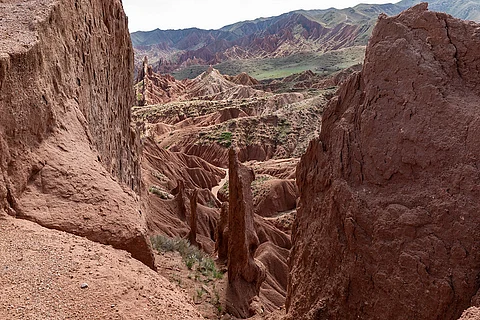
- Destinations
- Experiences
- Stay
- What's new
- Celebrating People
- Responsible Tourism
- CampaignsCampaigns
- SubscribeSubscribe
- Buy Now

Tucked along the quiet southern shores of Lake Issyk-Kul, there’s a place that feels like it belongs in a bedtime story more than on a map. Locals call it Skazka, which means “Fairy Tale” in Russian—and the name couldn’t be more perfect.
Set between the towns of Karakol and Jeti-Ögüz in Kyrgyzstan’s highlands, this canyon isn’t vast or grand in the way famous landscapes often are. But what it lacks in size, it more than makes up for in soul. Here, nature doesn’t shout—it whispers. Every curve, every ridge, every splash of color feels like part of a dream you half-remember.
Over thousands of years, wind and rain have quietly carved Skazka’s soft sandstone and clay into shapes that stir the imagination. The colours are mesmerizing—deep reds, warm oranges, pale yellows, and dusty whites blend together like fire meeting sky.
But what truly captivates are the forms: a dragon curled in eternal slumber, a crumbling castle perched on a ridge, even a sunken ship caught in a sea of sand. Some say they see a witch’s hat; others, a sleeping giant. There’s no right answer—only your own story.
Skazka doesn’t feel like a canyon shaped by force. It feels like something imagined—like a place that simply appeared one day, waiting to be discovered.
In Kyrgyzstan, stories live in everything—from mountain peaks to stones underfoot—and Skazka is no exception. People don’t just visit this place; they interpret it. One person might point at a rock and say, “That’s a lion.” Another might reply, “No, it’s a gate to another world.”
That’s the beauty of it: you don’t just walk through the canyon—you create your own fairy tale as you go. The land doesn’t speak with facts; it speaks with feeling. You see what your heart is ready to see.
There’s a legend locals love to tell—a story passed down through generations. Once, the valley of Issyk-Kul was home to thriving cities. In one of them lived a young woman so beautiful that she caught the eye of a powerful dragon. The dragon fell in love with her, but she did not love him back. Heartbroken and angry, the dragon vowed to drown every city in the valley.
Every night, he used his magic to pull water from the wells, but the people were clever—they covered the wells with golden lids to block him. Then, one evening, the young woman forgot to seal her well. The dragon saw his chance and flooded the entire valley, creating what is now Lake Issyk-Kul.
Mesmerized by the lake’s beauty, the dragon lay down on the southern shore—and as he rested, he turned to stone. That is the shape many now see in the rocks of Skazka Canyon.
There are no marked trails here. No fences. No signs telling you where to go or what to see. And that’s exactly what makes Skazka so special. You’re free to wander—up the ridges, through narrow gullies, or into little nooks that feel like they were made just for you.
Climb high enough, and you’ll see Lake Issyk-Kul glimmering in the distance. Stay low, and you might find yourself caught in a shadow that feels like a doorway to another world.
Some people come here to hike. Others come to sit quietly, soaking in the silence and the sun. A few whisper wishes into the wind. It’s that kind of place.
Skazka Canyon is only about an hour’s drive (40 km) from Karakol. While the last stretch of road is gravel, it’s manageable with most cars. A small fee—just a dollar or two—helps support the upkeep of the site.
The canyon is most magical at sunrise or sunset, when the colours come alive and the stones seem to glow from within. Summers can be hot and dry, so bring water, sunscreen, and shoes you don’t mind getting dusty.
There aren’t any shops or restrooms in the canyon itself, but nearby villages offer warm meals, cosy yurt stays, and unbeatable views of the lake.
More than just a place to visit, Skazka is a place to feel. It’s not about checking a box or snapping a perfect photo—it’s about pausing, wondering, and letting your imagination run wild. Because in Fairy Tale Canyon, the land doesn’t just tell stories—it invites you to write your own.
The closest airport to Skazka Canyon is Manas International Airport (FRU) in Bishkek, Kyrgyzstan. From Bishkek, you can reach the canyon by renting a car, taking a taxi, or using public transportation. A common way to reach the canyon from Bishkek is by taking a marshrutka (minibus) to Balykchy and then hiring a taxi to the canyon, or by taking a marshrutka heading east along the southern shore of Issyk-Kul Lake.
The best time to visit Skazka Canyon is from late spring to early autumn, specifically May through September, when the weather is most favorable. This period offers comfortable temperatures and clear skies, ideal for exploring the canyon's vibrant colours. While July and August are peak tourist months, visiting in May or September can provide a quieter experience.
